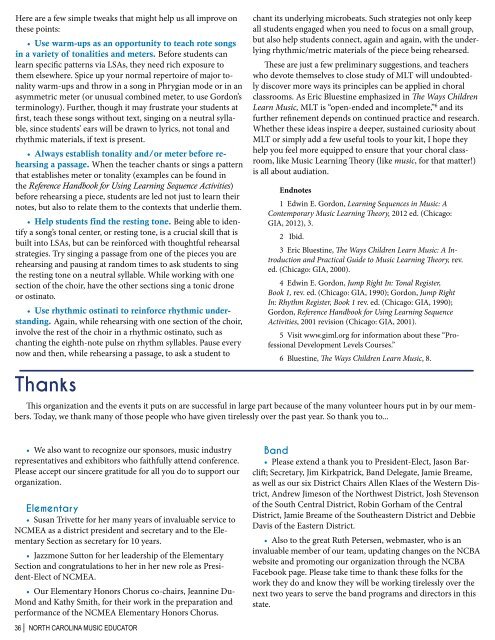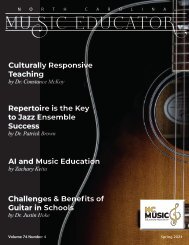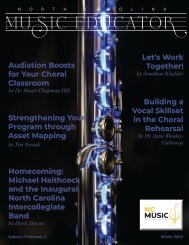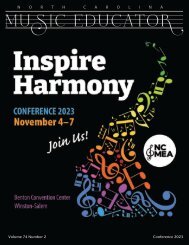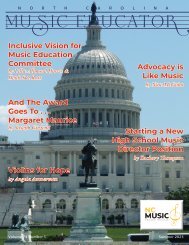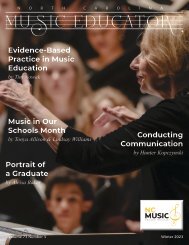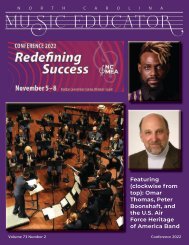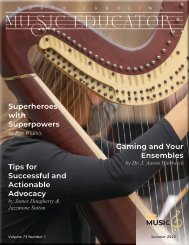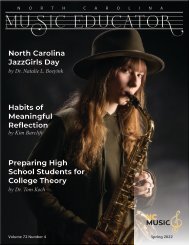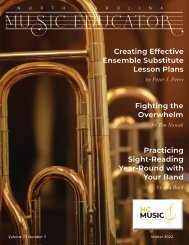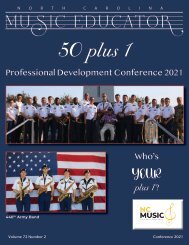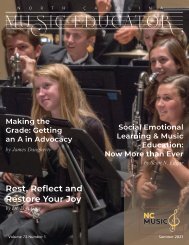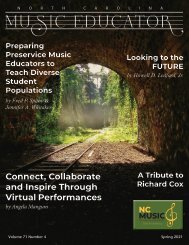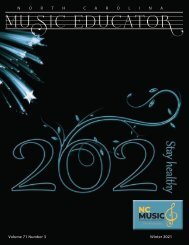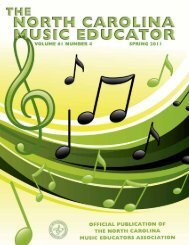NC Music Educator Winter 2017
North Carolina Music Educators Association Journal Winter 2017
North Carolina Music Educators Association Journal Winter 2017
- No tags were found...
You also want an ePaper? Increase the reach of your titles
YUMPU automatically turns print PDFs into web optimized ePapers that Google loves.
Here are a few simple tweaks that might help us all improve on<br />
these points:<br />
• Use warm-ups as an opportunity to teach rote songs<br />
in a variety of tonalities and meters. Before students can<br />
learn specific patterns via LSAs, they need rich exposure to<br />
them elsewhere. Spice up your normal repertoire of major tonality<br />
warm-ups and throw in a song in Phrygian mode or in an<br />
asymmetric meter (or unusual combined meter, to use Gordon’s<br />
terminology). Further, though it may frustrate your students at<br />
first, teach these songs without text, singing on a neutral syllable,<br />
since students’ ears will be drawn to lyrics, not tonal and<br />
rhythmic materials, if text is present.<br />
• Always establish tonality and/or meter before rehearsing<br />
a passage. When the teacher chants or sings a pattern<br />
that establishes meter or tonality (examples can be found in<br />
the Reference Handbook for Using Learning Sequence Activities)<br />
before rehearsing a piece, students are led not just to learn their<br />
notes, but also to relate them to the contexts that underlie them.<br />
• Help students find the resting tone. Being able to identify<br />
a song’s tonal center, or resting tone, is a crucial skill that is<br />
built into LSAs, but can be reinforced with thoughtful rehearsal<br />
strategies. Try singing a passage from one of the pieces you are<br />
rehearsing and pausing at random times to ask students to sing<br />
the resting tone on a neutral syllable. While working with one<br />
section of the choir, have the other sections sing a tonic drone<br />
or ostinato.<br />
• Use rhythmic ostinati to reinforce rhythmic understanding.<br />
Again, while rehearsing with one section of the choir,<br />
involve the rest of the choir in a rhythmic ostinato, such as<br />
chanting the eighth-note pulse on rhythm syllables. Pause every<br />
now and then, while rehearsing a passage, to ask a student to<br />
chant its underlying microbeats. Such strategies not only keep<br />
all students engaged when you need to focus on a small group,<br />
but also help students connect, again and again, with the underlying<br />
rhythmic/metric materials of the piece being rehearsed.<br />
These are just a few preliminary suggestions, and teachers<br />
who devote themselves to close study of MLT will undoubtedly<br />
discover more ways its principles can be applied in choral<br />
classrooms. As Eric Bluestine emphasized in The Ways Children<br />
Learn <strong>Music</strong>, MLT is “open-ended and incomplete,” 6 and its<br />
further refinement depends on continued practice and research.<br />
Whether these ideas inspire a deeper, sustained curiosity about<br />
MLT or simply add a few useful tools to your kit, I hope they<br />
help you feel more equipped to ensure that your choral classroom,<br />
like <strong>Music</strong> Learning Theory (like music, for that matter!)<br />
is all about audiation.<br />
Endnotes<br />
1 Edwin E. Gordon, Learning Sequences in <strong>Music</strong>: A<br />
Contemporary <strong>Music</strong> Learning Theory, 2012 ed. (Chicago:<br />
GIA, 2012), 3.<br />
2 Ibid.<br />
3 Eric Bluestine, The Ways Children Learn <strong>Music</strong>: A Introduction<br />
and Practical Guide to <strong>Music</strong> Learning Theory, rev.<br />
ed. (Chicago: GIA, 2000).<br />
4 Edwin E. Gordon, Jump Right In: Tonal Register,<br />
Book 1, rev. ed. (Chicago: GIA, 1990); Gordon, Jump Right<br />
In: Rhythm Register, Book 1 rev. ed. (Chicago: GIA, 1990);<br />
Gordon, Reference Handbook for Using Learning Sequence<br />
Activities, 2001 revision (Chicago: GIA, 2001).<br />
5 Visit www.giml.org for information about these “Professional<br />
Development Levels Courses.”<br />
6 Bluestine, The Ways Children Learn <strong>Music</strong>, 8.<br />
Thanks<br />
This organization and the events it puts on are successful in large part because of the many volunteer hours put in by our members.<br />
Today, we thank many of those people who have given tirelessly over the past year. So thank you to...<br />
• We also want to recognize our sponsors, music industry<br />
representatives and exhibitors who faithfully attend conference.<br />
Please accept our sincere gratitude for all you do to support our<br />
organization.<br />
Elementary<br />
• Susan Trivette for her many years of invaluable service to<br />
<strong>NC</strong>MEA as a district president and secretary and to the Elementary<br />
Section as secretary for 10 years.<br />
• Jazzmone Sutton for her leadership of the Elementary<br />
Section and congratulations to her in her new role as President-Elect<br />
of <strong>NC</strong>MEA.<br />
• Our Elementary Honors Chorus co-chairs, Jeannine Du-<br />
Mond and Kathy Smith, for their work in the preparation and<br />
performance of the <strong>NC</strong>MEA Elementary Honors Chorus.<br />
Band<br />
• Please extend a thank you to President-Elect, Jason Barclift;<br />
Secretary, Jim Kirkpatrick, Band Delegate, Jamie Breame,<br />
as well as our six District Chairs Allen Klaes of the Western District,<br />
Andrew Jimeson of the Northwest District, Josh Stevenson<br />
of the South Central District, Robin Gorham of the Central<br />
District, Jamie Breame of the Southeastern District and Debbie<br />
Davis of the Eastern District.<br />
• Also to the great Ruth Petersen, webmaster, who is an<br />
invaluable member of our team, updating changes on the <strong>NC</strong>BA<br />
website and promoting our organization through the <strong>NC</strong>BA<br />
Facebook page. Please take time to thank these folks for the<br />
work they do and know they will be working tirelessly over the<br />
next two years to serve the band programs and directors in this<br />
state.<br />
36 | NORTH CAROLINA MUSIC EDUCATOR


